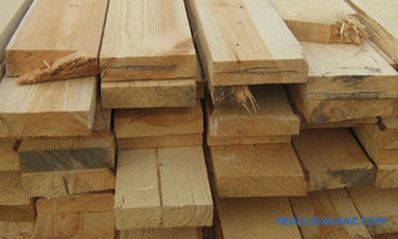The foundation is the part of the building that cannot be redone, corrected or supplemented with any elements after construction. You can install additional walls, expand or vice versa, lay openings, complete the additional floor, change the roof structure, and the foundation will still remain as you build it during construction.
In order for the house to be strong and reliable, you need a solid foundation that can withstand any vagaries of nature and weight loads.
Preparatory work
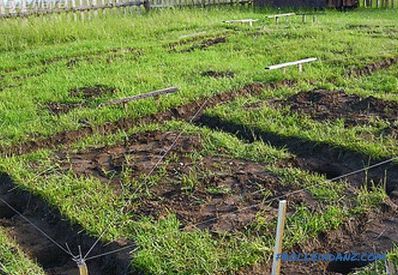 Border marking and digging of the excavation
Border marking and digging of the excavation
Location of the construction site is the main factor to choose the type of foundation. You will determine what foundation your home will have at the design stage after conducting a soil survey.
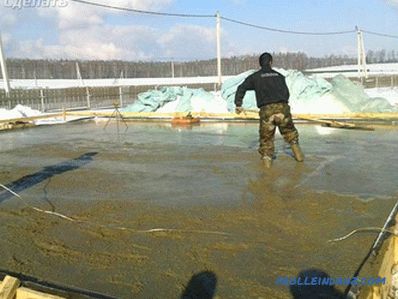 Filling of the tile base
Filling of the tile base
The most expensive construction is considered to be a monolithic foundation. Its construction is necessary if the construction site is located on marshy soils. For other types of soil, strip foundations or columnar with grillage are poured.
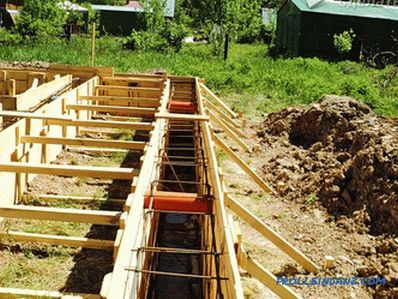 Formwork and reinforcement cage
Formwork and reinforcement cage
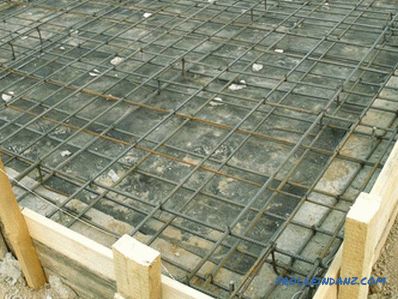 Reinforcement of slab foundations
Reinforcement of slab foundations
Preparatory work should be carried out qualitatively with full compliance with the technology.
These include:
- Accurate and efficient marking of the boundaries of the foundation.
- Qualitatively executed earthworks. The required depth of the pit is dug according to the project and the chosen type of foundation.
- Laying a sand cushion with a layer of at least 20 cm.
- Installation of formwork around the perimeter of the foundation of solid wood. Shields should be placed strictly parallel on both sides of the pit. The upper part is interconnected by crossbars. The formwork itself requires maximum compliance with the installation rules. The shift towards the formwork wall will entail a violation of the foundation structure and its strength.
- Installation inside the steel frame formwork. It is the main binder of concrete. The quality of the frame will provide the necessary design strength of the base. For a bundle of reinforcement use wire. It is possible to connect the rods by welding, but this procedure increases the cost of the foundation.
- Approach to the building of all communication branches and device in the design of the base of the ventilation ducts.
Preparation of the concrete solution
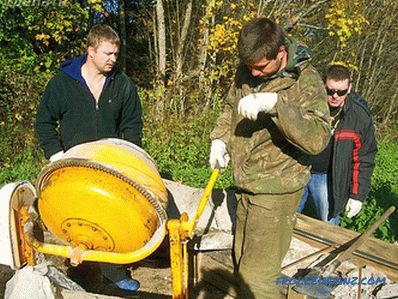
The preparatory work was completed and carried out according to all the rules. The next stage is the preparation of a quality solution. The basis of concrete is cement. A solid, quality foundation can be poured using cement grade 300 or 400.
The hygroscopicity of the solution depends on the type of cement used. It is very important that the cement comes to the construction site in whole packs and is stored according to the requirements written on the bags.
In addition to cement, good sand, crushed stone of middle fraction and water are also needed. Materials must be purchased for future use, so that the base was poured immediately, not in parts. Why is that? About this you will learn further.
A rapidly hardening mixture needs immediate use. Making concrete in small portions, they need to be quickly poured into the foundation, and this is unproductive and time consuming.
For small volumes of construction, concrete mixers are used. If the building is large or it is necessary to fill the tile foundation, it is better to order the concrete mix at the factory.
Filling technology
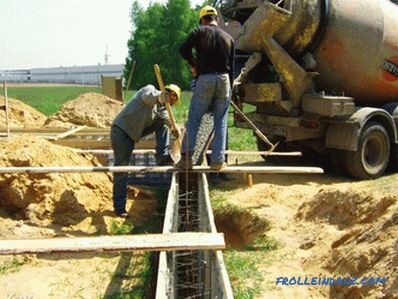
You just need to pour the prepared mixture into the formwork and evenly distribute it over the entire area of the base. For a foundation to be strong and of high quality, it is necessary:
- Remove the air bubbles formed from the foundation structure. To do this, you will need a deep vibrator or shovel. For tamping use the stalk. It is desirable to tamp the mixture before it starts to harden.
- The surface of the mortar should be well leveled and level checked horizontality.
- In order for the foundation to gain strength as quickly as possible and better, it must be covered with foil. If the air temperature is too high, it is advisable to periodically wet the surface with water.
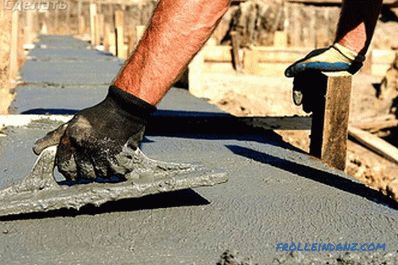 Leveling the Foundation
Leveling the Foundation
If all the work is done properly, the foundation of the house will be reliable and durable .
Questions from readers and answers of specialists
Can the foundation be poured with parts
It is advisable to fill the foundation of the building immediately in order to obtain a monolithic structure. There are many different situations in life and sometimes there is simply no way to do concreting in one go. You can do the casting in parts if you follow the rules:
- Split the base into compartments vertically. Pour each compartment at a time.
- For a bundle of compartments, there should be fittings that will be wasted from the filled-in part.
- Before you start pouring the next compartment, you must pour the wall of the previous compartment with water.
When pouring a slab foundation, you cannot interrupt the process of concreting.
What are the optimal conditions for concreting?
It is better to lay the foundation for the building when the outside temperature is above zero. Work can be carried out in the fog or with a little rain. At high air humidity, concrete hardens better.
In construction technology there is a winter base molding, but it is very complex.
Do not start construction if the air temperature is not more than +5 degrees.
How to prepare a solution for a columnar or strip base?
The amount of solution needed for your base can be calculated from the project. Having learned volume of the base, you will know the volume of the required concrete solution.
3 parts of crushed stone of middle fraction and sand and one part of M400 cement are laid in the concrete mixer.
How to properly fill a monolithic foundation
For a monolithic structure, you need to install a solid formwork and fill it in one go. A drainage system must be installed under the tile foundation. When the system is installed, a layer of sand is poured and compacted.
A reinforcement cage is installed on top and a solid formwork is being installed. A large amount of concrete is required for tiled foundations, so it is better to order special equipment and ready-made concrete. The rest of the work can be done independently.
Errors
Errors can be avoided if you know about them:
- Refusal to conduct geological exploration.
- Wrong foundation type selected.
- Incorrect load calculation.
- Savings on formwork material. Poor quality of mounting boards.
- Partial mating of reinforcement.
- The finished foundation is left under the scorching rays of the sun without shelter.
- Violation of the proportionality of the components of the solution.
We advise you to read:
- a fence made of sheeting with a foundation;
- how to build a simple gazebo.
Video


